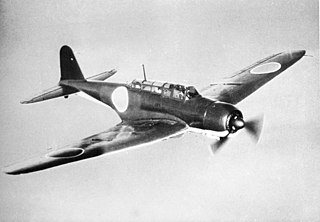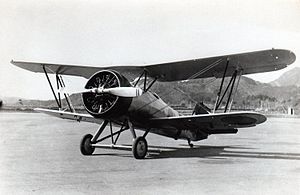
The Mitsubishi A5M, formal Japanese Navy designation Mitsubishi Navy Type 96 Carrier-based Fighter (九六式艦上戦闘機), experimental Navy designation Mitsubishi Navy Experimental 9-Shi Carrier Fighter, company designation Mitsubishi Ka-14, was a WWII-era Japanese carrier-based fighter aircraft. The Type number is from the last two digits of the Japanese imperial year 2596 (1936) when it entered service with the Imperial Navy.

The Nakajima B5N was the standard carrier-based torpedo bomber of the Imperial Japanese Navy (IJN) for much of World War II. It also served as a high level bomber.

The Nakajima J1N1 Gekkō is a twin-engine aircraft used by the Imperial Japanese Navy during World War II. A prototype first flew in May 1941. The first full production variant of the Gekkō, the J1N1-C was a reconnaissance aircraft, although many of these underwent field modification into night fighters; in addition, a night fighter variant, the J1N1-S was later put into production. Towards the end of the war, J1N1 pilots also undertook kamikaze anti-shipping missions. The Gekkō was given the Allied reporting name "Irving".

The Kawasaki Ki-10 was the last biplane fighter used by the Imperial Japanese Army, entering service in 1935. Built by Kawasaki Kōkūki Kōgyō K.K. for the Imperial Japanese Army, it saw combat service in Manchukuo and in North China during the early stages of the Second Sino-Japanese War. Its reporting name given by the Allies was "Perry".

The Aichi D1A or Navy Type 94/96 Carrier Bomber was a Japanese carrier-based dive bomber of the 1930s. A single-engine, two-seat biplane based on the Heinkel He 50, the D1A was produced by Aichi for the Imperial Japanese Navy, remaining in service as a trainer at the time of the attack on Pearl Harbor. The D1A was produced in two variants, the D1A1, and the D1A2.

The Nakajima A1N, or Navy Type 3 Carrier Fighter, was a Japanese carrier-based fighter of the late-1920s and early-1930s. It was a licensed copy of the British Gloster Gambet fighter, built by the Nakajima Aircraft Company for the Imperial Japanese Navy. Approximately 150 were built in two versions, the A1N1 and A1N2.

The Yokosuka B4Y was a carrier-borne torpedo bomber used by the Imperial Japanese Navy Air Service from 1936 to 1943. The B4Y replaced the Mitsubishi B2M2 and the Yokosuka B3Y, and was the last biplane bomber used operationally by the Imperial Japanese Navy. The Allied reporting name was "Jean". This aircraft was mistakenly identified by the British as the Nakajima Navy G-96.

The Nakajima A2N or Navy Type 90 Carrier Fighter was a Japanese carrier-borne fighter of the 1930s. It was a single-engined biplane of mixed construction, with a fixed tailwheel undercarriage.
The Nakajima Ha1 Kotobuki was an aero-engine developed by Nakajima. It was a radial piston developed under licence from the Bristol Jupiter.

The Nakajima Army Type 91 Fighter was a Japanese fighter of the 1930s. It was a single-engine, single-seat parasol monoplane with a fixed, tailskid undercarriage.

The Nakajima Ki-4Kyūyon-shiki teisatsuki (九四式偵察機) was the last biplane reconnaissance aircraft of the Japanese Imperial Army. It saw combat service in Manchukuo and in north China during the early stages of the Second Sino-Japanese War.

The Kugisho B3Y, or Navy Type 92 Carrier Attack Bomber, also popularly titled Yokosuka B3Y, was a Japanese carrier-based torpedo bomber of the 1930s. It was designed by the Naval Air Technical Arsenal at Yokosuka, and while unimpressive during testing, it was ordered into service by the Imperial Japanese Navy and used until replaced by more capable aircraft.

The Mitsubishi Ki-18 was an unsuccessful and unsolicited attempt by Mitsubishi to meet a 1934 requirement issued by the Japanese Army for a modern single-seat monoplane fighter suitable to the needs of the Imperial Japanese Army Air Force. During this competition, Nakajima entered the Nakajima Ki-11, and Kawasaki entered the more maneuverable Kawasaki Ki-10 biplane. The competition was won by Kawasaki, but the new fighter was not accepted by the IJAAF with much enthusiasm.

The Kawasaki Ki-28, World War II Allied reporting name "Bob", was an experimental fighter aircraft designed for the Imperial Japanese Army and meant as a replacement for the Kawasaki Ki-10. It flew in 1936, but was never produced for actual use as the Army chose the Nakajima Ki-27.

The Mitsubishi Ki-33 was an experimental monoplane fighter aircraft designed for the Japanese Imperial Army. Two prototypes flew in 1936 but the design never entered production.
The Nakajima C3N-1 was a prototype Japanese carrier-based reconnaissance aircraft of the 1930s. A single-engine monoplane with a fixed undercarriage, although only two examples were built, they were both used operationally, carrying out land-based reconnaissance missions during the Second Sino-Japanese War.
The Nakajima B3N was a prototype Japanese carrier-based torpedo-bomber aircraft of the 1930s. A single-engined biplane with a crew of three, it was unsuccessful, only two being built.
The Nakajima Ha5 is a twin row, 14 cylinder air-cooled radial aircraft engine built by the Japanese Nakajima Aircraft Company. The engine was a development of earlier single-row Japanese engines, the Kotobuki and Hikari, which had combined features of the Bristol Jupiter and Pratt & Whitney R-1340 Wasp designs.

The Mitsubishi 1MF10 or Mitsubishi Experimental 7-Shi Carrier Fighter (七試艦上戦闘機) was a prototype Japanese monoplane single-seat carrier-based fighter aircraft of the 1930s. Two were built for the Imperial Japanese Navy, but both were lost in crashes, with no production following.
The Nakajima D3N was a Japanese carrier-based dive bomber of the 1930s. Three prototypes were built for the Imperial Japanese Navy, but no production followed, with the Aichi D3A being selected instead.
















